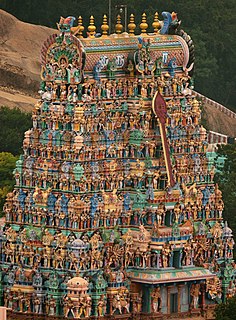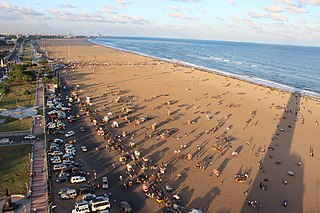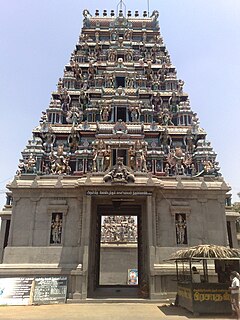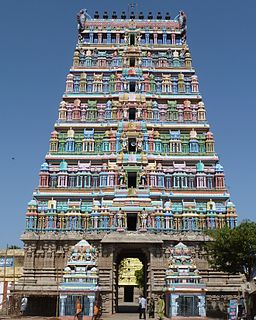
Thaipusam or Thaipoosam, is a festival celebrated by the Hindu Tamil community on the full moon in the Tamil month of Thai (January/February), usually coinciding with Pushya star, known as Poosam in Tamil. The festival is also observed among Hindu Keralites and is vernacularly called Thaipooyam.

Palani (Tamil: [paɻani], is a town and a taluk headquarters in Dindigul district of the western part of Tamil Nadu state in India. It is located about 106 kilometres south-east of Coimbatore and 122 kilometres north-west of Madurai, 67 kilometres from Kodaikanal. The Palani Murugan Temple or Arulmigu Dhandayuthapani Swamy Temple, dedicated to Lord Murugan is situated on a hill overlooking the town. The temple is visited by more than 7 million pilgrims each year. As of 2011, the town had a population of 126,751 which makes it the second largest town in the district after Dindigul.

Sangameswarar temple is a temple in Bhavani, in the Erode district, of the Indian state of Tamil Nadu. It is a Hindu temple dedicated to Lord Shiva. It is 15 km from Erode, 30 km from Gobichettipalayam, 56 km from Salem and 106 km from Coimbatore.

Chennimalai is a town in Erode district, Tamil Nadu, India. It is popularly known as the 'Handloom Town'.

The Vayalur Murugan Temple is a Hindu temple dedicated to Muruga, son of Lord Shiva and Parvati, located in the village of Kumaravayalur in Tiruchirapalli district, Tamil Nadu, India. The temple is believed to have been initiated during the period of Medieval Cholas during the 9th century. The temple is maintained and administered by the Hindu Religious and Charitable Endowments Department of the Government of Tamil Nadu. Though the presiding deity is Shiva, the temple is known for the Murugan shrine. The temple is associated with Hindu savant, Kirupanandha Variyar.

Arulmigu Subramaniya Swamy Temple, Thiruparankundram is a Hindu temple and one of the Six Abodes of Murugan, located at Thiruparankundram, Tamilnadu, India. The temple is built in rock-cut architecture and believed to have been built by the Pandyas during the 6th century. According to the legend it is where Murugan slayed the demon Surapadman and married Deivayanai, the divine daughter of the king of heaven, Indra, and he is said to have worshipped Shiva here as Parangirinathar.

Arulmigu Subramaniya Swamy Temple is a Hindu temple, on the hill of Thiruttani, Tiruvallur district, Tamil Nadu, India, dedicated to Lord Muruga. The hill has 365 steps indicating 365 days of the year. It is fifth among the six abodes of Lord Muruga The other five are Palani Murugan Temple, Swamimalai Murugan Temple, Thiruchendur Murugan Temple, Thiruparankundram and Pazhamudircholai Murugan Temple. Thiruttani is 87 kilometres (54 mi) from Chennai. Earlier Thiruttani was called as Thiruveragam,After correct Demon Tharagan (Soorasamharam) he got subsided his angry so here Kandha sasti festival (Soorasamharam) is not conducted.

Swaminatha Swamy Temple is a Hindu temple dedicated to god Murugan. It is located in Swamimalai, 5 km from Kumbakonam, on the banks of a tributary of river Kaveri in Thanjavur District, 250 km from Chennai, the capital of Tamil Nadu, India. The temple is fourth abode of Murugan among six (Arupadaiveedugal). The shrine of the presiding deity, Swaminathaswamy is located atop a 60 ft (18 m) hillock and the shrine of his mother Meenakshi (Parvathi) and father Shiva (Sundareswarar) is located downhill. The temple has three gopuram, three precincts and sixty steps and each one is named after the sixty Tamil years. The temple has six daily rituals at various times from 5:30 a.m. to 9 p.m., and three yearly festivals on its calendar. The annual Vaikasi Visagam festival is attended by thousands of devotees from far and near.

Arulmigu Dhandayuthapani Swamy Temple is third of the Six Abodes of Murugan. It is located in the city of Palani earlier it was known as Thiruaavinankudi(as mentioned in the old Sangam literature Thirumurugatrupadai), Dindigul district, 100 kilometres (62 mi) southeast of Coimbatore and northwest of Madurai in the foothills of the Palani Hills, Tamil Nadu, India. Palani temple is considered synonymous with Panchamritam, a sweet mixture made of five ingredients.

Pambatti siddhar was one of the 18 siddhars, a lineage of monks or sages who lived at various time periods in India, mainly southern India. Some of his poems, roughly around 600 lines of text are available today. His poems are written in Tamil and he is famous for finishing his poems with the term 'Addu Pambe' which literally means 'dance, o snake'. Even his poems are addressed to snakes. Some of his poems also addresses his spiritual teacher or guru. Pambatti siddhar comes from the line of saints who are believed to have possessed siddhis or supernatural powers through rigorous meditation and other spiritual exercises. He is also believed to have caught snakes and sold them for living before he ventured into his spiritual quest.

The Pundarikakshan Perumal Temple or Thiruvellarai Temple in Thiruvellarai, a village in the outskirts of Tiruchirappalli in the South Indian state of Tamil Nadu, is dedicated to the Hindu god Vishnu. Constructed in the Dravidian style of architecture, the temple is glorified in the Divya Prabandha, the early medieval Tamil canon of the Azhwar saints from the 6th–9th centuries AD. It is one of the 108 Divyadesam dedicated to Vishnu, who is worshipped as Pundarikakshan and his consort Lakshmi as Pankajavalli.

Tiruppukkozhiyur is a Hindu temple dedicated to the deity Shiva, located in Avinasi, a panchayat town in Tiruppur district in the South Indian state of Tamil Nadu. Shiva is worshipped as Avinasiappar, and is represented by the lingam. His consort Parvati is depicted as Karunambigai. The presiding deity is revered in the 7th century Tamil Saiva canonical work, the Tevaram, written by Tamil saint poets known as the Nayanars and classified as Paadal Petra Sthalam.

Tamil Nadu has the largest tourism industry in India with a percentage share of 21.31% and 21.86% of domestic and foreign tourist visits in the country. According to the 2020 Ministry of Tourism report, the number of domestic arrivals was at 494.8 million making the state the second most popular tourist destination in the country, and foreign arrivals numbered 6.86 million, the highest in the country, making it the most popular state for tourism in the country.

Pariyur is a panchayat village located near Gobichettipalayam in Erode District of Tamil Nadu state, India. It is located about 3 km from Gobichettipalayam on the way to Anthiyur via Savandapur. It is a religious center with many famous temples including the Pariyur Kondathu Kaliamman temple.

Uthirakosamangai, also known as Mangalanatha Swamy temple, is a Shaiva temple situated near Ramanathapuram in the Ramanathapuram district of Tamil Nadu. The temple is much older and the structure as it exists today is believed to be built by the Pandya kings, Achutappa Nayak, Muthuveerappar and other kings of Ramanthapuram at various times. The temple has been glorified by the hymns of 9th-century saint Manickavasagar and 15th-century saint Arunagirinathar.

The Hindu Religious and Charitable Endowments Department of the Government of Tamil Nadu manages and controls the temple administration within the state. The Tamil Nadu Hindu Religious and Charitable Endowments Act XXII of 1959 controls 36,425 temples, 56 mutts or religious orders, 1,721 specific endowments and 189 trusts.

Arthanāreeswarā temple aka Thirukodimāda Chenkundrūr(Tamil: திருக்கொடிமாடச் செங்குன்றூர்) is an ancient Hindu temple, located in Tiruchengode, in the southern Indian state of Tamil Nadu. The temple is dedicated to Arthanāreeswarā, a form of the Hindu deity Shiva combined with his consort Parvati. Also called asMādhorubāgan and Ammaiyappan (mother-father). The famous Chenkottu Velavar Temple, dedicated to Lord Murugan, is also situated on the same hill.

Balasubramaniyaswamy temple in Vennaimalai, a village in the outskirts of Karur in Karur district in the South Indian state of Tamil Nadu, is dedicated to the Hindu god Murugan. Constructed in the Dravidian style of architecture, the temple is located in the Karur - Pugalur Road. The legend of the temple is associated with Kamadhenu taking up the duties of Hindu god of creation Brahma and creating the hill of butter named Vennaimalai.

Thirumeninathar temple is a Hindu temple dedicated to the deity Shiva, located in Tiruchuli in Virudhunagar district, in the South Indian state of Tamil Nadu. Shiva is worshipped as Thirumeninathar, and is represented by the lingam. His consort Parvati is depicted as Thunaimalaiyammai Amman. The temple is located on the Virudhunagar–Manamadurai road. The presiding deity is revered in the 7th century Tamil Saiva canonical work, the Tevaram, written by Tamil saint poets known as the nayanmars and classified as Paadal Petra Sthalam. The temple is closely associated with Sundarar, who has sung praises about the presiding deity. This shrine is regarded as the 12th of the Tevara Stalams in the Pandya region of Tamil Nadu.

Uthiyur is a small town in Kangeyam taluk of Tiruppur district in south Indian state of Tamil Nadu.























